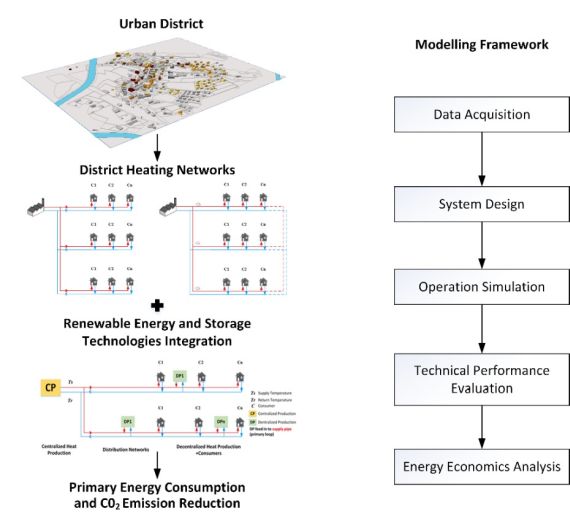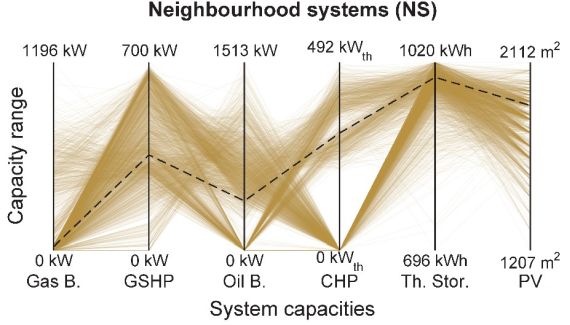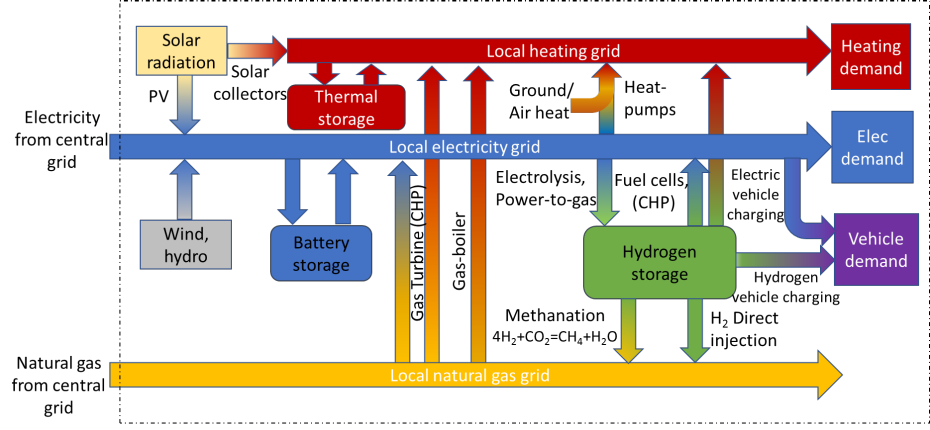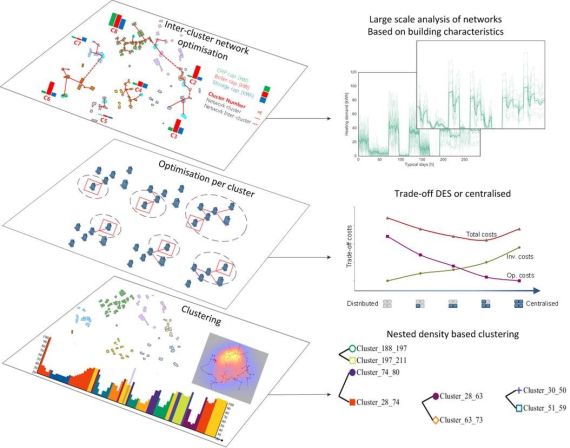Energy system modelling and optimization
The increasing penetration of renewable energy sources (e.g. solar, wind) opens up opportunities for greater energy autonomy and improved sustainability, but also introduces new dynamics into local (e.g. neighborhood and district) energy systems. To ensure an efficient matching of supply and demand of different energy streams, comprehensive simulation and optimization approaches are needed, covering multiple energy streams and the multitude of transformation possibilities. The Urban Energy Systems Laboratory develops and tests modelling methodologies to assess the performance (e.g. sustainability, financial) of local energy systems and identify optimal solutions for their design and operation.
Renewable powered district heating networks (RePoDH)
In the urban context, the utilization of thermal networks for the distribution of heat to buildings has proven to be an energy efficient method for satisfying the heating demand of multiple distributed consumers with varying usage patterns. However, while thermal networks can be a useful solution, it is often a challenge to integrate multiple energy resources into district heating systems. Especially when the temperature dynamics of the different energy conversion technologies are accounted for. As a result, the development of a robust design methodology for district heating systems is a demanding task. The SNF project RePoDH aims to deepen the knowledge in this area by developing a modelling framework to design district-heating networks powered by renewable conversion technologies (e.g. solar thermal collectors, low energy sources with heat pumps), in combination with short and long-term storage technologies (e.g. hot water storage tanks, boreholes). An assessment of the different DHS configurations is performed based on specific performance indicators such as renewable share, overall system losses, and CO2 emissions.

Design of distributed urban energy systems under uncertainty
The effective design of distributed urban energy systems is hindered by uncertainty, which can be traced in aspects like the stochastic nature of renewable energy or the unknown future energy prices. Any design decisions that are made ignoring uncertainty can potentially be rendered suboptimal if the conditions assumed during the design stage deviate due to uncertainty from the actual conditions during the system’s operating phase.
To address the issue of uncertainty, computational techniques are combined with the energy hub concept in order to investigate uncertainty’s impacts on the optimal design of urban energy systems (Uncertainty Analysis) as well as the most influential uncertainty sources (Sensitivity Analysis). Additionally, extensions to the deterministic energy hub modelling framework are developed that allow for optimal and robust system design decisions to be made under uncertainty (Stochastic and Robust Optimization).

Integration of sustainable multi-energy HUB systems (IMES): power to gas for district energy systems
Due to the phase out of centralized fossil fuel and nuclear power plants in favor of renewable generation in Switzerland, new solutions are predicted to shift power grids towards a structure of decentralized energy systems (DES). Distributed storage is an asset in DES design as it can mitigate stochastic fluctuations in renewable generation by shifting surpluses to future demand. Currently, the majority of DES models focus on batteries or thermal tanks as a storage medium, while power-to-gas (P2G) storage, in which excess electricity is converted to storable hydrogen gas via electrolysis, is typically reserved for large renewable facilities. However, P2G is also an attractive storage option at the community level, as it facilitates long-term storage with high energy density. The research project IMES-BP (SNF NFP70) attempts to address this oversight by applying P2G as a long-term storage solution in DES modelling. The DES model is based on the energy hub concept, with new elements introduced to accurately represent P2G technology.

Multiscale urban energy system optimization using spatio-temporal clustering
To identify the optimal energy supply system for a given district or urban area, we must be able to develop a computationally tractable model of the problem. When dealing with larger system (e.g. hundreds or thousands of buildings) this can be a significant challenge. This research focuses on analyzing the trade-offs between centralized and decentralized energy systems, and in particular on the development and evaluation of model reduction (i.e. clustering and decomposition) techniques in the spatial and temporal dimension. The main research question is: How can different model reduction techniques facilitate the identification of an optimal balance between centralized and decentralized approaches in district energy system planning? For reducing the temporal dimension, techniques such as rolling horizon, typical days and receding horizon are tested. For reducing the spatial dimension, a novel iterative combined clustering method is developed which enables fine-grained optimization in the spatial dimension while preserving computational tractability.

References
Allegrini J, Orehounig K, Mavromatidis G, Ruesch F, Dorer V, Evins R. (2015) A review of modelling approaches and tools for the simulation of district-scale energy systems. Renewable and Sustainable Energy Reviews, Vol 52, 1391-1404. https://www.sciencedirect.com/science/article/pii/S1364032115007704?via%3Dihub
Bollinger, L.A., Davis, C.B., Evins, R., Chappin, E.J.L., Nikolic, I. Multi-model ecologies for shaping future energy systems: Design patterns and development paths (2018) Renewable and Sustainable Energy Reviews, 82, pp. 3441-3451. https://doi.org/10.1016/j.rser.2017.10.047
Bollinger, L.A., Dorer, V. The Ehub Modeling Tool: A flexible software package for district energy system optimization, Energy Procedia, Volume 122, 2017, pp. 541-546. https://doi.org/10.1016/j.egypro.2017.07.402
Marquant, J.F., Evins, R., Bollinger, L.A. Carmeliet, J.. A holarchic approach for multi-scale distributed energy system optimisation, Applied Energy, Volume 208, 2017, pp. 935-953. https://doi.org/10.1016/j.apenergy.2017.09.057
Mavromatidis G, Orehounig K, Carmeliet J. (2015) Climate change impact on the design of urban energy systems. In: International Conference Future Buildings & Districts, Sustainability from Nano to Urban Scale, CISBAT 2015, Lausanne, Switzerland, September 9th – 11th 2015. https://www.dora.lib4ri.ch/empa/islandora/object/empa%3A14642/datastream/PDF/view
Mavromatidis G, Orehounig K, Carmeliet J. (2016) Uncertainty and sensitivity analysis for the optimal design of distributed urban energy systems. In: Sustainable Built Environment Conference, SBE16, Zurich, Switzerland, June 13th – 17th 2016. https://www.dora.lib4ri.ch/empa/islandora/object/empa%3A13600/datastream/PDF/view
Morvaj, B., Evins, R., Carmeliet, J. Decarbonizing the electricity grid: The impact on urban energy systems, distribution grids and district heating potential, Applied Energy, Volume 191, 2017, pp. 125-140. https://doi.org/10.1016/j.apenergy.2017.01.058
Omu A, Hsieh S, Orehounig K. (2016) Mixed integer linear programming for the design of solar thermal energy systems with short-term storage. Applied Energy 180, 313-326. https://doi.org/10.1016/j.apenergy.2016.07.055
Orehounig K, Evins R, Dorer V. (2015) Integration of decentralized energy systems in neighbourhoods using the energy hub approach. Applied Energy, Vol 154, 277-289. https://doi.org/10.1016/j.apenergy.2015.04.114
Orehounig, K., Mavromatidis, G., Evins, R., Dorer, V., Carmeliet, J. (2014) 'Towards an energy sustainable community: an energy system analysis for a village in Switzerland' Energy and Buildings, Vol 84, 277-286. https://www.sciencedirect.com/science/article/pii/S0378778814006549
Wu R, Mavromatidis G, Orehounig K. (2016) Reliability Optimisation of a District Multi-Energy System. In: 19. Status-Seminar, ETH Zurich, Switzerland, September 8th – 9th 2016
Wu R, Mavromatidis G, Orehounig K, Carmeliet J. (2017) Multiobjective Optimisation of Energy Systems and Building Envelope Retrofit in a Residential Community. Applied Energy, 190, 634-649 https://doi.org/10.1016/j.apenergy.2016.12.161

-
Share
